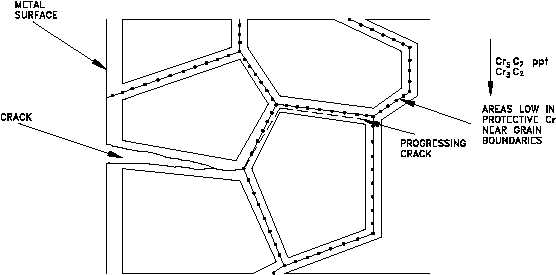Corrosion
DOE-HDBK-1015/1-93
SPECIALIZED CORROSION
Rev. 0
CH-02
Page 33
Figure 14 Intergranular Corrosion Cracking
Figure 14 illustrates intergranular stress corrosion cracking. The pressure of a tensile
stress opens up intergranular cracks and accelerates further corrosion. Chloride stress
corrosion is a particularly significant problem in the operation of nuclear facilities
because of the wide use of austenitic stainless steel, and the inherent presence of high
tensile stresses associated with pressurization. Chloride stress corrosion cracks have
been known to propagate in austenitic stainless steel at stresses of about one-fifth yield
strength with chloride concentrations of less than 50 ppm. Yield strength is discussed
in detail in the Material Science Handbook.
Tests show that the 18-8 stainless steels are susceptible to chloride stress attack when
both the chloride ion concentration and dissolved oxygen concentration are above certain
values. The region of susceptibility for austenitic stainless steel is illustrated in Figure
15. Note that when dissolved oxygen is present at about 1 ppm, chloride stress
corrosion cracking can be initiated at chloride ion concentrations near 1 ppm. However,
when the concentration of dissolved oxygen is very low, susceptibility to chloride stress
corrosion cracking is reduced.
High temperature tends to decrease the time required for chloride-induced cracking to
occur, but there appears to be no practical temperature limit below which cracking will
not occur, given sufficient time and severe conditions. The curve in Figure 15 is valid for
temperatures in the range 470?F to 500?F.

